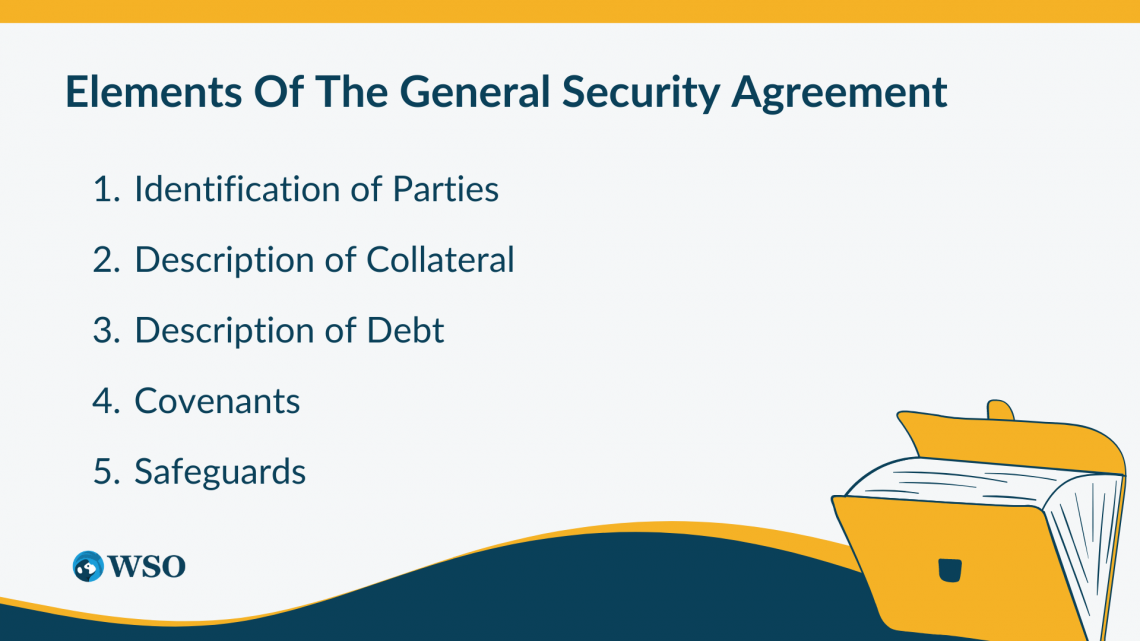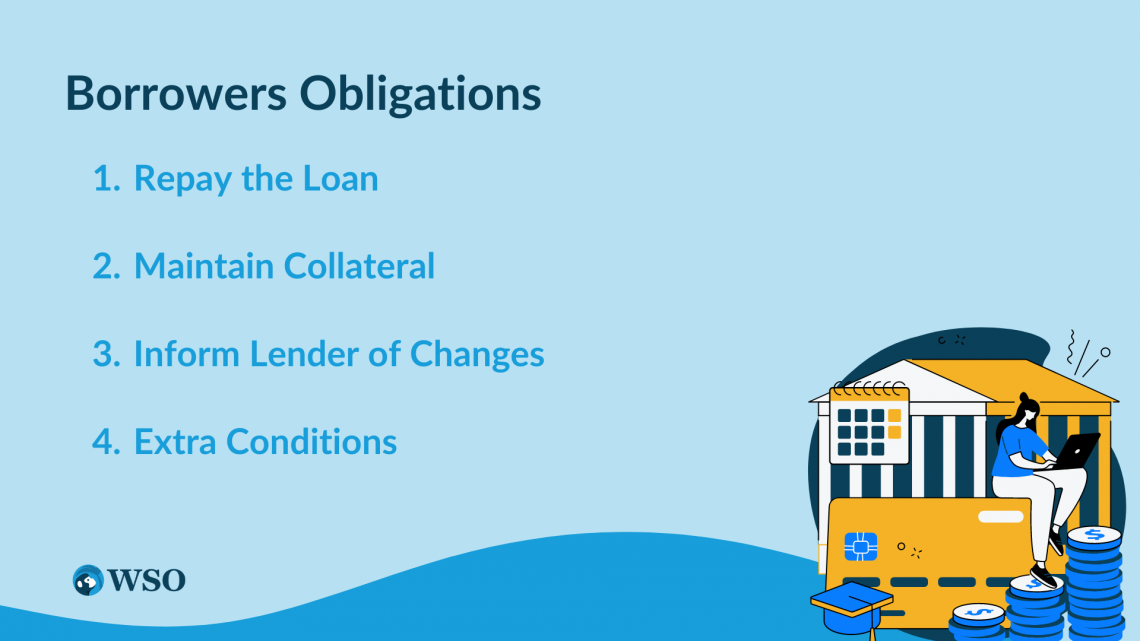General Security Agreement
It is a legal document that establishes and governs the collateral provided for a loan.
When taking out a commercial or personal loan, banks or other credit institutions want security in their loans. This security often comes in the form of collateral and assets. If a borrower defaults on their loan, they sell those assets to cover the costs.

A General Security Agreement, or GSA, is a binding contract between a borrower and a lender regarding the collateral put up. The agreement will set up a security interest on all assets pledged as collateral.
While it seems like a Security Agreement benefits only the lender, it can help both the lender and the borrower. By entering into a GSA, the lender obtains a form of security for the funds they have lent, while the borrower gains access to the loan they require.
If the borrower were to default on their loan, the agreement would serve as a legally binding statement that the lender has the right to collect the assets that were put up as collateral and sell them to make up for the loss.

While these agreements can secure collateral, they can’t secure real property. In legal and financial contexts, securing collateral means providing a form of guarantee or pledge that can be used to satisfy a debt or obligation in the event of default.
For example, GSAs aren’t generally used to secure houses as they would likely be part of a mortgage agreement rather than a GSA, which has different rules and laws specifically designed for such transactions.
Key Takeaways
- A General Security Agreement is a legal document that establishes and governs the collateral provided for a loan.
- A GSA will contain all information of both parties.
- All obligations and responsibilities of a borrower will be stated in the GSA.
- GSAs are crucial in formalizing the collateral arrangement and providing legal protection for both the borrower and the lender in the loan transaction.
Purpose Of The General Security Agreement
One of the primary purposes of a General Security Agreement (GSA) is to provide legal documentation that establishes a lender's right to claim collateral. Without proper documentation, any attempt to claim collateral would be considered illegal.

The GSA ensures that the lender has a valid and enforceable claim to the collateral in the event of a borrower's loan default.
When signed, the GSA gives the lender a sense of security with the collateral. It makes the collection of collateral forcible by law. A GSA can cover multiple assets, not just a single asset like a vehicle. This flexibility allows a broader range of assets to be included as collateral.
Moreover, a GSA can outline specific conditions related to the assets. It can regard assets that fluctuate in value and how to handle the loan if the collateral’s value drops. For example, if a car is put up for collateral and gets damaged, it suddenly loses its value.
The loan becomes uninsured, and the bank is afraid that the borrower won’t be able to make their payments due to the accident. In such a case, the lender may require the borrower to replace the damaged collateral with a new asset.

Alternatively, the loan terms may be adjusted to accommodate the increased risk, such as shortening the loan term or increasing the interest rate.
Some states may require that lenders register collateral and the GSA to a public database. When uploaded to a public database, the collateral pledge is trackable. This allows the public and lenders to check if an asset is already pledged to another loan or lender.
In such a scenario, some lenders would have a borrower find another asset to use. Most lenders require a piece of collateral that is not attached to any outside credit besides a mortgage. Usually, the original debt must be paid off to use an existing piece of collateral.
NOTE
Registering a GSA in a public database is generally accepted and provides benefits to both the borrower and the lender.
When a database is involved, it should be renewed periodically to ensure the information remains current. Outdated data in the database serves little purpose. The lender must renew all GSAs. Unfortunately, updates often come at the cost of the borrower.
They are required to respond to a request to update and provide all information the lender requires. It can take a long time to confirm and finalize a new GSA through this process. Also, the update adds another layer of complication to the loan.
What Are The Elements Of The General Security Agreement?
While a GSA is a simile document in theory, multiple elements and sections of a GSA make it more complicated. Each piece is made to ensure the process of putting up collateral is smooth. It also contains multiple preventative measures to ensure the stability of the loan.

Reviews of a GSA can be found at the SEC. They provide unfilled documents and guidelines on how a GSA can be found. Items in this document include:
1. Identification of Parties
The GSA should clearly identify and provide the names and descriptions of all parties involved in the loan. This includes individuals and businesses, facilitating easy identification and understanding of the parties' roles.
2. Description of Collateral
All assets pledged to the loan should be described. A description of the item, its use, the class of collateral, and any other identifiable description of the asset should be listed.
A good description lets both parties fully understand what asset is being used as collateral, regardless of prior knowledge. It can help to clear some confusion with the collateral.
NOTE
Different types of collateral have different laws, values, uses, and regulations. A poorly described asset could cause a lender or bank to incorrectly file a GSA. This can lead to a number of legal problems for the borrower and lender.
3. Description of Debt
This section outlines the borrower's obligations and responsibilities concerning the loan. It covers all aspects of the debt, including payment schedules and any other present or future obligations.
4. Covenants
A check on the assets is also important. This section declares that the assets are being used for this specific loan.
NOTE
It also declares that the asset is free of any encumbrances (such as liens, claims, and other attachments).
5. Safeguards
In the event of a default or loan failure, the GSA must have measures to ensure that a loan and the lender will not fail. When a borrower fails to pay their loan, it puts the lender at risk of not making back their money.
A GSA will tell you exactly how to collect collateral and how to transfer ownership. In case the collateral devalues, a GSA will also dictate what will happen in those situations.
NOTE
Each agreement may differ depending on the specific bank or lender. Therefore, when applying for a loan, it is advisable to carefully review the terms and conditions of each bank to understand the specific requirements and provisions of their GSAs.
Borrowers Obligations
There are multiple requirements a borrower must follow for the loan to not close. If any of these obligations are neglected, it can lead to the borrower losing the loan and the lender collecting the collateral put up.

1. Repay the Loan
The most obvious and important role of the borrower is to pay back the loan they’ve taken out. This can be in the form of monthly payments over years of repayment or upfront payments when they’ve secured enough cash to do so.
These payments will contain the base payment, interest on the loan, fees, and other additional charges. The borrower must be on time with these payments, as the GSA covers all obligations.
A GSA will record all current and future obligations the borrower needs to fulfill.
NOTE
Since the GSA is a reusable document, a lender can use it regardless of the loan status to repossess any collateral pledged.
2. Maintain Collateral
It is the borrower's responsibility to maintain the value and condition of the collateral provided. If the collateral were to lose value, this would put the bank at a higher risk of losing their money.
Collateral is important to securing a loan. If a loan doesn’t have collateral attached, it is at a higher risk for the lenders. If the borrower were to default on their loan, the lenders would have no way to get back their investment.
In the case of collateral losing its value, the lender will most likely postpone the loan to redraw the loan terms or outright call for the loan to be paid in full. If the lender chooses the ladder option, the borrower and lender will have to resettle terms.
Most loans will be paused during the resettlement, but some may continue under the previous terms. The lender and borrower will have to discuss new terms regarding interest, monthly payments, and loan terms. Also, there may be a change in collateral.
NOTE
The easiest way to solve collateral devaluation is to change the assets to something more valuable, add assets to increase the overall value, or try to increase the original collateral's value (like a renovation/update).
3. Inform Lender of Changes
It is important to inform the lender if changes occur to the collateral, such as modifications or alterations. For example, cars and vehicles are often used as collateral on loans. If the car owners change their car in any way (engine, color, internals), the lender should know of these changes.
Even if the asset's value doesn’t change, a change in an asset could affect its chances of being sold or valued by the bank. Most banks don’t enjoy changes as they add unprecedented factors to the loan.
Most banks plan their investments off the steady flow of income they get from loans. When collateral changes, it can throw problems into their stream of income. This can have a multitude of effects that can harm the health of a credit institution.
NOTE
It's important that whenever your collateral changes, you notify the bank. If you wait too long to notify the bank, it could result in problems with your bank or fees.
4. Extra Conditions
Extra conditions, such as a warranty on an asset, should be given to a lender. If an asset is insured, it could be a stronger piece of collateral than its secured insurance.
Other documents like ownership and payments should be given to the lender so they may make the most accurate evaluation. These documents ensure that the collateral is genuine and doesn’t conflict with the loan or other interests.
Summary
A General Security Agreement is an agreement written to confirm collateral for loans. These agreements help to secure collateral and the legality of said collateral. With agreements written, the loan is now legal and secured.

This agreement will dictate a number of terms throughout the loan, including identities of parties, descriptions of the loan and collateral, covenants, and safeguards. These components contribute to the proper functioning of the loan and provide clarity and transparency for all parties involved.
With an agreement settled, all assets put up as collateral are now tied to the loan. They cannot be used to support any other type of loan or credit. The database of agreements maintains this.
Most agreements have been uploaded to a dedicated server where the public and credit institutions can check and verify a collateral’s legitimacy and past. It can also be used to look up the condition of the collateral, as most agreements contain a description of the collateral.




or Want to Sign up with your social account?